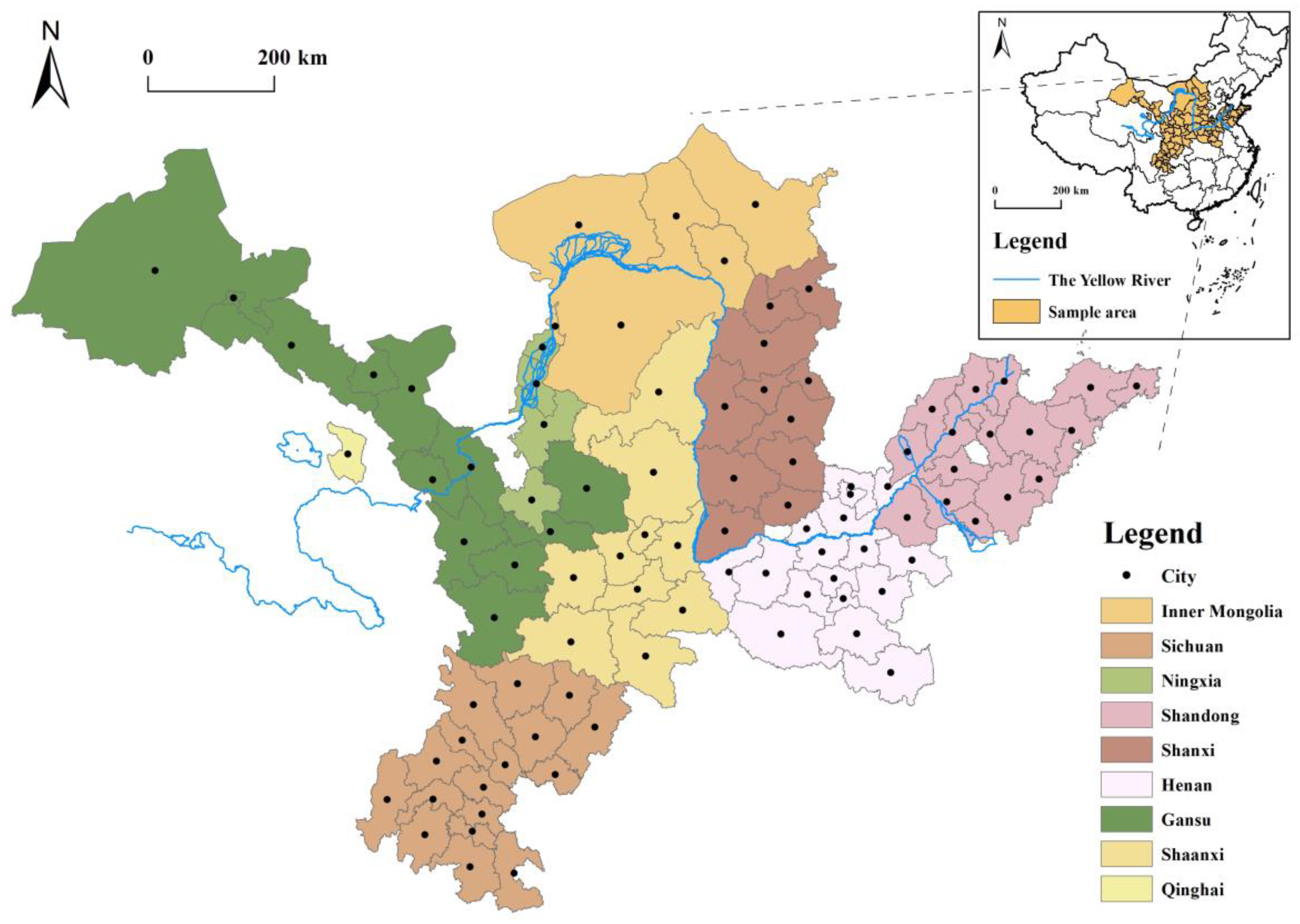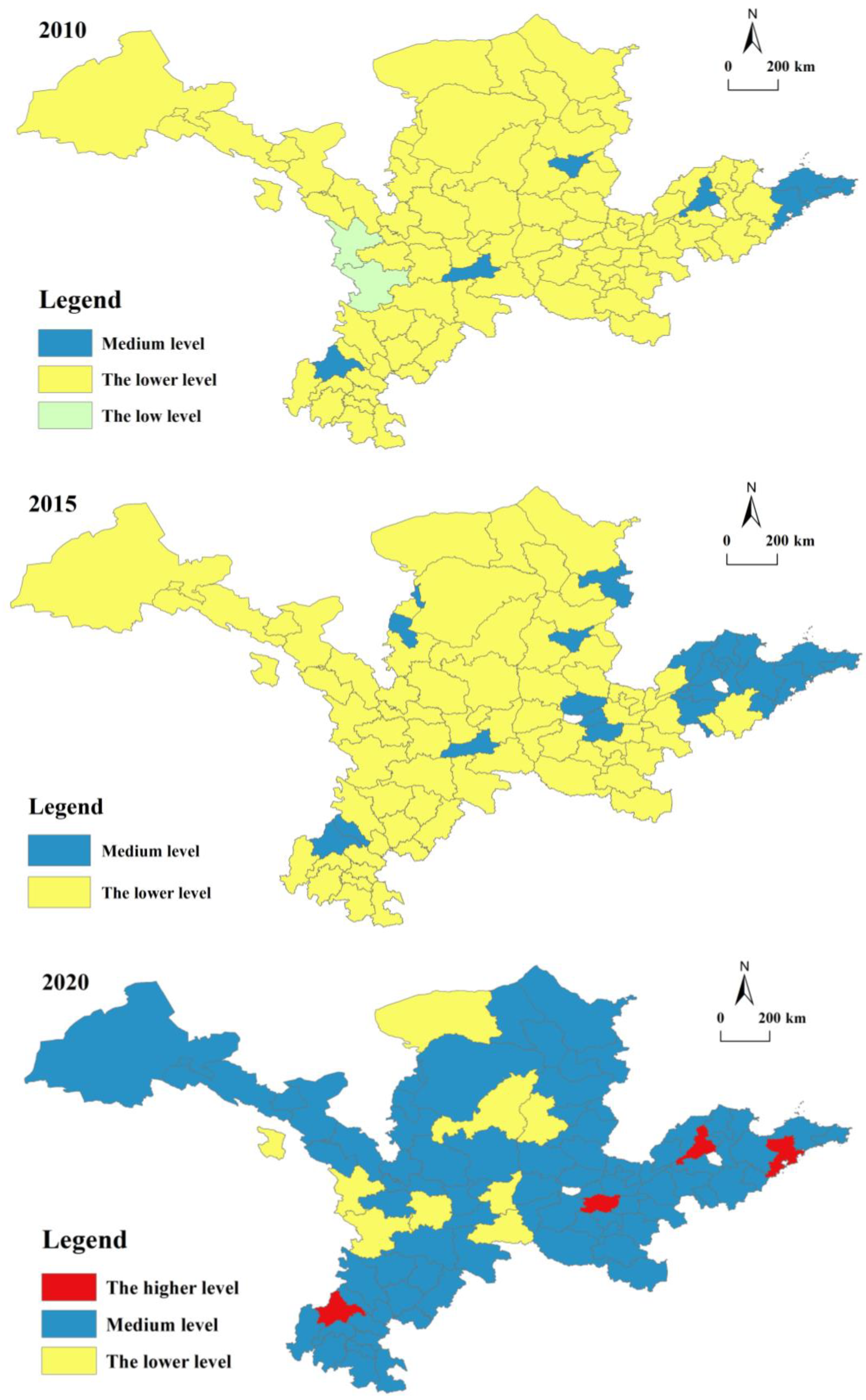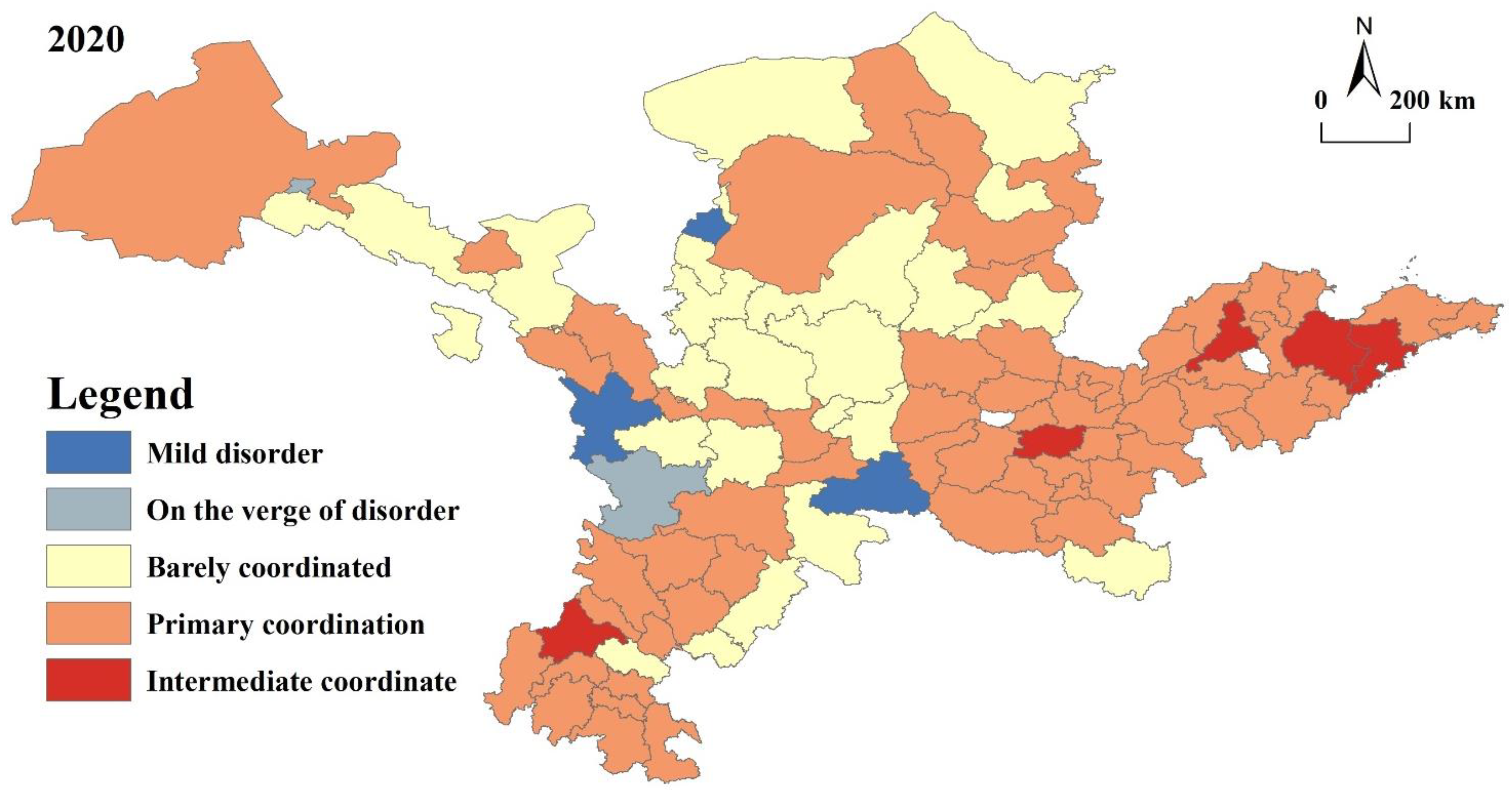Measuring the Level of Urban–Rural Integration Development and Analyzing the Spatial Pattern Based on the New Development Concept: Evidence from Cities in the Yellow River Basin
Abstract
1. Introduction
2. Literature Review
2.1. Study of the URI’s Connotation
2.2. URI Evaluation Index System Construction
2.3. A study of the Factors Influencing Urban–Rural Integration
3. Indicator System Construction
3.1. Study Area
3.2. Construction of the Index System
4. Data Sources and Research Methods
4.1. Data Sources
4.2. Research Methods
4.2.1. The Entropy Method
4.2.2. Coupling Degree Model
- (1)
- Degree of development calculation
- (2)
- Coupling level
- (3)
- Degree of coordination calculation
5. Analysis of the Spatial and Temporal Characteristics of URD Levels in the YRB
5.1. Spatial–Temporal Analysis of the Urban Development Level in the YRB
5.2. Spatial–Temporal Analysis of Rural Development Level in the YRB
6. Spatial and Temporal Analysis of the URID in the YRB
6.1. Analysis of Temporal Changes in URIs
6.2. Spatial Differentiation Pattern of URIs
- (1)
- High-level coordination areas show a scattered distribution.
- (2)
- The low-level coordination area presents a certain degree of geographical lock-in.
6.3. Spatial Autocorrelation Analysis
7. Conclusions and Implications
7.1. Conclusions
7.2. Study Implications
Author Contributions
Funding
Institutional Review Board Statement
Informed Consent Statement
Data Availability Statement
Conflicts of Interest
References
- Wu, Y.Z.; Long, H.L.; Zhao, P.J.; Hui, E.C.M. Land use policy in urban-rural integrated development. Land Use Policy 2022, 115, 106041. [Google Scholar] [CrossRef]
- Fang, C.L. On integrated urban and rural development. J. Geog. Sci. 2022, 32, 1411–1426. [Google Scholar] [CrossRef]
- Yin, X.M.; Chen, J.; Li, J.Z. Rural innovation system: Revitalize the countryside for a sustainable development. J. Rural. Stud. 2022, 93, 471–478. [Google Scholar] [CrossRef]
- Rao, C.; Gao, Y. Evaluation Mechanism Design for the Development Level of Urban-Rural Integration Based on an Improved TOPSIS Method. Mathematics 2022, 10, 380. [Google Scholar] [CrossRef]
- Liu, Y.S.; Liu, Y.; Chen, Y.F.; Long, H.L. The process and driving forces of rural hollowing in China under rapid urbanization. J. Geog. Sci. 2010, 20, 876–888. [Google Scholar] [CrossRef]
- Chen, M.X.; Zhou, Y.; Huang, X.R.; Ye, C. The Integration of New-Type Urbanization and Rural Revitalization Strategies in China: Origin, Reality and Future Trends. Land 2021, 10, 207. [Google Scholar] [CrossRef]
- Chen, M.X.; Liu, W.D.; Lu, D.D.; Chen, H.; Ye, C. Progress of China’s new-type urbanization construction since 2014: A preliminary assessment. Cities 2018, 78, 180–193. [Google Scholar] [CrossRef]
- Zhong, W.-y.; Qi, J.-l.; Zhou, D. Review of urban-rural integration evaluation: Connotation identification, theoretical analysis, and system reconstruction. J. Nat. Resour. 2021, 36, 2634–2651. [Google Scholar]
- Fuchs, R.B.R.J. Secondary Cities in Developing Countries: Policies for Diffusing Urbanizationby Dennis A. Rondinelli. Econ. Geogr. 1983, 59, 461–462. [Google Scholar] [CrossRef]
- He, Y.; Zhou, G.; Tang, C.; Fan, S.; Guo, X. The spatial organization pattern of urban-rural integration in urban agglomerations in China: An agglomeration-diffusion analysis of the population and firms. Habitat. Int. 2019, 87, 54–65. [Google Scholar] [CrossRef]
- Masser, I.; Rondinelli, D.A. “Applied Methods of Regional Analysis: The Spatial Dimensions of Development Policy” (Book Review). Town. Plan. Rev. 1986, 57, 203. [Google Scholar] [CrossRef]
- Zheng, Y.X.; Tan, J.D.; Huang, Y.P.; Wang, Z.Y. The Governance Path of Urban-Rural Integration in Changing Urban-Rural Relationships in the Metropolitan Area: A Case Study of Wuhan, China. Land 2022, 11, 1334. [Google Scholar] [CrossRef]
- Zhang, Z.; Lu, Y. China’s urban-rural relationship: Evolution and prospects. China Agric. Econ. Rev. 2018, 10, 260–276. [Google Scholar] [CrossRef]
- Cui, S.Q.; Zhou, G.H.; Dai, L.Y.; Wu, G.H.; He, Y.H. Research Progress and Prospects of Urban-rural Integrated Development Based on Geographical Perspective. Econ. Geogr. 2022, 42, 104–113. [Google Scholar]
- Liu, Y.S.; Long, H.L.; Chen, Y.F.; Wang, J.Y.; Li, Y.R.; Li, Y.H.; Yang, Y.Y.; Zhou, Y. Progress of research on urban-rural transformation and rural development in China in the past decade and future prospects. J. Geog. Sci. 2016, 26, 1117–1132. [Google Scholar] [CrossRef]
- Chen, M.X.; Ye, C.; Lu, D.D.; Sui, Y.W.; Guo, S.S. Cognition and construction of the theoretical connotations of new urbanization with Chinese characteristics. J. Geog. Sci. 2019, 29, 1681–1698. [Google Scholar] [CrossRef]
- Jin, C.W. A Critical Reference to Contemporary Theories of Development Economics: A Theoretical Synthesis Based on Chinese Urban-rural Integrated Development. Econ. Res. J. 2019, 54, 183–197. [Google Scholar]
- Zhou, J.; Qin, F.; Liu, J.; Zhu, G.; Zou, W. Measurement, spatial-temporal evolution and influencing mechanism of urban-rural integration level in China from a multidimensional perspective. China Popul. Resour. Environ. 2019, 29, 166–176. [Google Scholar]
- Sicular, T.; Ximing, Y.; Gustafsson, B.; Shi, L. The urban-rural income gap and inequality in China. Rev. Income Wealth 2007, 53, 93–126. [Google Scholar] [CrossRef]
- Zarifa, D.; Seward, B.; Milian, R.P. Location, location, location: Examining the rural-urban skills gap in Canada. J. Rural. Stud. 2019, 72, 252–263. [Google Scholar] [CrossRef]
- Tian, Y.S.; Qian, J.; Wang, L. Village classification in metropolitan suburbs from the perspective of urban-rural integration and improvement strategies: A case study of Wuhan, central China. Land Use Policy 2021, 111, 105748. [Google Scholar] [CrossRef]
- Rickardsson, J. The urban–rural divide in radical right populist support: The role of resident’s characteristics, urbanization trends and public service supply. Ann. Reg. Sci. 2021, 67, 211–242. [Google Scholar] [CrossRef]
- Ma, L.B.; Liu, S.C.; Fang, F.; Che, X.L.; Chen, M.M. Evaluation of urban-rural difference and integration based on quality of life. Sustain. Cities Soc. 2020, 54, 101877. [Google Scholar] [CrossRef]
- Seale, E. Coping Strategies of Urban and Rural Welfare Organisations and the Regulation of the Poor. New Political Econ. 2013, 18, 141–170. [Google Scholar] [CrossRef]
- Zhu, H.; Deng, F.M.; Liang, X.D. Overall Urban-Rural Coordination Measures-A Case Study in Sichuan Province, China. Sustainability 2017, 9, 189. [Google Scholar] [CrossRef]
- Liu, Y.S.; Zhang, F.G.; Zhang, Y.W. Appraisal of typical rural development models during rapid urbanization in the eastern coastal region of China. J. Geog. Sci. 2009, 19, 557–567. [Google Scholar] [CrossRef]
- Liu, Y.S.; Lu, S.S.; Chen, Y.F. Spatio-temporal change of urban-rural equalized development patterns in China and its driving factors. J. Rural. Stud. 2013, 32, 320–330. [Google Scholar] [CrossRef]
- Xu, C.Y.; Qian, C.; Yang, W.C.; Li, B.W.; Kong, L.Q.; Kong, F.B. Spatiotemporal Pattern of Urban-Rural Integration Development and Its Driving Mechanism Analysis in Hangzhou Bay Urban Agglomeration. Int. J. Environ. Res. Public. Health 2022, 19, 8390. [Google Scholar] [CrossRef] [PubMed]
- Sun, Y.G.; Yang, Q.S. Study on Spatial-Temporal Evolution Characteristics and Restrictive Factors of Urban-Rural Integration in Northeast China from 2000 to 2019. Land 2022, 11, 1195. [Google Scholar] [CrossRef]
- Castle, E.N.; Wu, J.J.; Weber, B.A. Place Orientation and Rural-Urban Interdependence. Appl. Econ. Perspect. Policy 2011, 33, 179–204. [Google Scholar] [CrossRef]
- Kule, L. Urban-Rural Interactions in Latvian Changing Policy and Practice Context. Eur. Plan. Stud. 2014, 22, 758–774. [Google Scholar] [CrossRef]
- Cui, X.F.; Yang, S.; Zhang, G.H.; Liang, B.; Li, F. An Exploration of a Synthetic Construction Land Use Quality Evaluation Based on Economic-Social-Ecological Coupling Perspective: A Case Study in Major Chinese Cities. Int. J. Environ. Res. Public. Health 2020, 17, 3663. [Google Scholar] [CrossRef]
- Fu, Y.H.; Zhou, T.T.; Yao, Y.Y.; Qiu, A.G.; Wei, F.Q.; Liu, J.Q.; Liu, T. Evaluating efficiency and order of urban land use structure: An empirical study of cities in Jiangsu, China. J. Cleaner Prod. 2021, 283, 124638. [Google Scholar] [CrossRef]
- Ye, Q.Q.; Li, J.W.; Kong, X.S.; Zhang, S.K. Identification and Optimization of the Spatial Structure of Urban and Rural Settlements from a Hierarchical Network Perspective. Land 2021, 10, 1177. [Google Scholar] [CrossRef]
- Tang, D.Z.; Li, B.R.; Qiu, Y.; Zhao, L.L. Research on Urban and Rural Coordination Development and Its Driving Force Based on the Space-time Evolvement Taking Guangdong Province as an Example. Land 2020, 9, 253. [Google Scholar] [CrossRef]
- Li, L.; Ma, S.J.; Zheng, Y.L.; Xiao, X.Y. Integrated regional development: Comparison of urban agglomeration policies in China. Land Use Policy 2022, 114, 105939. [Google Scholar] [CrossRef]
- Cheng, M.Y.; Li, L.N.; Zhou, Y. Exploring the urban-rural development differences and influencing factors in the Huang-Huai-Hai Plain of China. J. Geog. Sci. 2020, 30, 1603–1616. [Google Scholar] [CrossRef]
- Tang, D.Z.; Mao, M.Y.; Shi, J.G.; Hua, W.W. The Spatio-Temporal Analysis of Urban-Rural Coordinated Development and Its Driving Forces in Yangtze River Delta. Land 2021, 10, 495. [Google Scholar] [CrossRef]
- Zang, Y.Z.; Yang, Y.Y.; Liu, Y.S. Understanding rural system with a social-ecological framework: Evaluating sustainability of rural evolution in Jiangsu province, South China. J. Rural. Stud. 2021, 86, 171–180. [Google Scholar] [CrossRef]
- Song, Z.J.; Chen, Y.; Li, Y.; Zhao, X. An Analysis of the Allometric and Multifractal Features of a Development in the Urban-Rural Area in the Lower Reaches of the Yangtze River: 2012 Cross-Sectional Data of Four Provinces and One City. Complexity 2020, 2020, 6963827. [Google Scholar] [CrossRef]
- Yang, Y.Y.; Bao, W.K.; Wang, Y.S.; Liu, Y.S. Measurement of urban-rural integration level and its spatial differentiation in China in the new century. Habitat. Int. 2021, 117, 102420. [Google Scholar] [CrossRef]
- Zhou, J.; Zou, W.; Qin, F. Review of urban-rural multi-dimensional integration and influencing factors in China based on the concept of equivalence. Geogr. Res. 2020, 39, 1836–1851. [Google Scholar]
- Chen, Y.; Zhu, M.K.; Lu, J.L.; Zhou, Q.; Ma, W.B. Evaluation of ecological city and analysis of obstacle factors under the background of high-quality development: Taking cities in the Yellow River Basin as examples. Ecol. Indic. 2020, 118, 106771. [Google Scholar] [CrossRef]
- Chen, C.; LeGates, R.; Zhao, M.; Fang, C. The changing rural-urban divide in China’s megacities. Cities 2018, 81, 81–90. [Google Scholar] [CrossRef]
- Rao, C.J.; Yan, B.J. Study on the interactive influence between economic growth and environmental pollution. Environ. Sci. Pollut. Res. 2020, 27, 39442–39465. [Google Scholar] [CrossRef]
- Zhao, W.; Jiang, C.J. Analysis of the Spatial and Temporal Characteristics and Dynamic Effects of Urban-Rural Integration Development in the Yangtze River Delta Region. Land 2022, 11, 1054. [Google Scholar] [CrossRef]
- Zhang, Z.Y.; Hu, Z.N.; Zhong, F.L.; Cheng, Q.P.; Wu, M.Z. Spatio-Temporal Evolution and Influencing Factors of High Quality Development in the Yunnan-Guizhou, Region Based on the Perspective of a Beautiful China and SDGs. Land 2022, 11, 821. [Google Scholar] [CrossRef]
- Deng, M.H.; Chen, J.F.; Tao, F.F.; Zhu, J.L.; Wang, M. On the Coupling and Coordination Development between Environment and Economy: A Case Study in the Yangtze River Delta of China. Int. J. Environ. Res. Public. Health 2022, 19, 586. [Google Scholar] [CrossRef]
- Fang, C.L.; Liang, L.W.; Chen, D. Quantitative simulation and verification of urbanization and eco-environment coupling coil in Beijing-Tianjin-Hebei urban agglomeration, China. Sustain. Cities Soc. 2022, 83, 103985. [Google Scholar] [CrossRef]








| Destination Layer | Criteria Layer | Index Layer | Calculation Method |
|---|---|---|---|
| Level of urban development | Innovation | Technology capital investment | Investment in science and technology as a proportion of fiscal expenditure/% |
| Scientific and technical outputs | Number of patents granted | ||
| Coordination | Population urbanization | Number of urban population/Total number of people at year end/% | |
| Disposable income per urban resident | Income of city residents/Number of urban population/% | ||
| Household Engel coefficient in cities | Coefficient of Urban Engel/% | ||
| Green | Greening coverage of built-up areas | Greening area of built-up area/Area of built-up area/% | |
| Industrial sulphur dioxide emissions rate | Industrial sulphur dioxide emissions/million tonnes | ||
| Rate of effective discard of household garbage | Harmless treatment rate of domestic waste in the built-up area/% | ||
| Open | Transport network density | Road mileage/administrative land area/km/km2 | |
| Internet Density | Number of internet users/urban population/% | ||
| Share | Number of people covered by urban basic health insurance | Number of people covered by urban basic health insurance/person | |
| Pupil–teacher ratio in city primary schools | Number of urban primary school teachers/primary school pupils/person | ||
| Electricity consumption per million urban residents | Electricity consumption by city residents/number of city residents | ||
| Level of rural development | Innovation | Growth rate of food production | Grain growth production/last year’s grain production |
| Total farm machinery power per unit area | Total agricultural machinery power/sown area | ||
| Coordination | Level of synchronized industrial development | Increase in the output value of primary production/Increase in the output value of secondary and tertiary production | |
| Inhabitants of country areas’ disposable income | Disposable income of country inhabitant | ||
| Household Engel coefficient in country | Household Engel coefficient in country | ||
| Green | Effective irrigated area | Effective irrigated area | |
| Fertilizer application efficiency | Fertilizer application/seeded area | ||
| Open | Transport accessibility | Number of buses per million population | |
| Share | Number of rural health facilities | Number of health institutions | |
| Electricity consumption per million rural residents | Rural residential electricity consumption/number of people in villages |
| Level of Coordination | Degree of Coherence (D) | Coordinated Subspecies Types | Level |
|---|---|---|---|
| High degree of coordination | 0.90~1.00 (A1) | High-quality coordination | 10 |
| 0.80~0.89 (A2) | Good coordination | 9 | |
| Moderate coordination | 0.70~0.79 (B1) | Intermediate coordinate | 8 |
| 0.60~0.69 (B2) | Primary coordination | 7 | |
| Basic coordination | 0.50~0.59 (C1) | Barely coordinated | 6 |
| 0.40~0.49 (C2) | On the verge of disorder | 5 | |
| Transitional coordination | 0.30~0.39 (D1) | Mild disorder | 4 |
| 0.20~0.29 (D2) | Moderate disorder | 3 | |
| Serious disorders | 0.10~0.19 (E1) | Severe disorder | 2 |
| 0.00~0.09 (E2) | Extreme imbalance | 1 |
Disclaimer/Publisher’s Note: The statements, opinions and data contained in all publications are solely those of the individual author(s) and contributor(s) and not of MDPI and/or the editor(s). MDPI and/or the editor(s) disclaim responsibility for any injury to people or property resulting from any ideas, methods, instructions or products referred to in the content. |
© 2022 by the authors. Licensee MDPI, Basel, Switzerland. This article is an open access article distributed under the terms and conditions of the Creative Commons Attribution (CC BY) license (https://creativecommons.org/licenses/by/4.0/).
Share and Cite
Wei, L.; Zhao, X.; Lu, J. Measuring the Level of Urban–Rural Integration Development and Analyzing the Spatial Pattern Based on the New Development Concept: Evidence from Cities in the Yellow River Basin. Int. J. Environ. Res. Public Health 2023, 20, 15. https://doi.org/10.3390/ijerph20010015
Wei L, Zhao X, Lu J. Measuring the Level of Urban–Rural Integration Development and Analyzing the Spatial Pattern Based on the New Development Concept: Evidence from Cities in the Yellow River Basin. International Journal of Environmental Research and Public Health. 2023; 20(1):15. https://doi.org/10.3390/ijerph20010015
Chicago/Turabian StyleWei, Leiru, Xiaojie Zhao, and Jianxin Lu. 2023. "Measuring the Level of Urban–Rural Integration Development and Analyzing the Spatial Pattern Based on the New Development Concept: Evidence from Cities in the Yellow River Basin" International Journal of Environmental Research and Public Health 20, no. 1: 15. https://doi.org/10.3390/ijerph20010015
APA StyleWei, L., Zhao, X., & Lu, J. (2023). Measuring the Level of Urban–Rural Integration Development and Analyzing the Spatial Pattern Based on the New Development Concept: Evidence from Cities in the Yellow River Basin. International Journal of Environmental Research and Public Health, 20(1), 15. https://doi.org/10.3390/ijerph20010015






